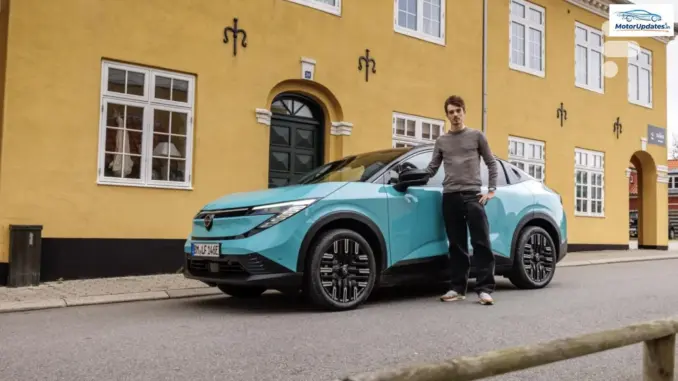
What happens when a 15-year-old EV is redesigned? The new Nissan Leaf shows the answer. It keeps its soul but grows up.
Design: Japanese roots, European aim
Why does it look different? Designers in Atsugi worked 18 months on this Leaf. They wanted a car tailored for Europe but with Japanese taste.
Does it still feel like a hatchback? Not really. It blends a compact sedan with a coupe-SUV silhouette. The shape targets low drag, achieving a Cx of 0.25.
Exterior details and cues
The front is clean and active. A full grille with active flaps reduces resistance and smooths airflow. The Nissan badge even lights up for a modern touch.
What about the lights? C-shaped LEDs and a horizontal light bar define the face. Rear lights reference old icons like the 300ZX, and subtle “ni” and “san” motifs appear 23 times. It’s a small designer wink.
Size and stance
The Leaf measures 4.35 m long, 1.81 m wide and 1.55 m tall. Wheels come in 18 or 19 inches. Door handles are flush up front and hidden at the rear for a coupe look.
Interior and practicality: bright but compact
Is the cabin airy? Yes. A liquid-crystal panoramic roof brings light while saving 7 kg over a classic shade. It filters UV and controls brightness.
How comfortable is it? The seats favor comfort over sport. Rear legroom is decent but not generous for tall adults. Think cozy rather than limousine.
Cargo and modularity
The boot holds 437 litres. Compartments hide cables and small items. It’s practical for daily life and weekend errands.
Infotainment and connectivity: Google takes the wheel
Why hand software to Google? Nissan uses Android Automotive OS for a familiar and capable interface. Google Maps and the Play Store run natively on the system.
Can you install Waze and apps directly? Yes. Apps like Waze and streaming services install without a phone. The system pairs with a 14.3‑inch main screen and a matching digital cluster.
Hardware and user features
What about audio and charging? A Bose setup is optional and wireless phone charging sits in the armrest. Multiple USB‑C ports serve front and rear passengers.
Is Apple compatibility gone? No. Apple CarPlay and Android Auto remain supported where relevant. Nissan’s added apps sit alongside Google’s ecosystem.
Driving aids: calm automation
Does it drive itself? Not fully. ProPilot Assist with Navi‑Link provides Level 2 semi-autonomy. It combines adaptive cruise, lane follow, speed prediction and sign recognition.
Is it adjustable? Yes. Assist settings can be saved and recalled by shortcut. The system tends to drift left sometimes, a common quirk.
One-pedal and regen behavior
Can you drive with one pedal? Not really. Regenerative braking has three levels and an e‑Pedal mode. The e‑Pedal slows to about 10 km/h but won’t come to a full stop without braking.
How does this compare? Renault’s Megane E‑Tech offers a truer one‑pedal feel. Here, e‑Pedal is more a convenience than a game changer.
Performance and driving feel
Is it sporty? No. With 218 horsepower, acceleration is respectable but not aggressive. 0–100 km/h takes 7.6 seconds and top speed is 160 km/h.
What does it feel like on the road? The Leaf is calm and refined. The steering is light and the suspension favors comfort. Think sofa, not sports car.
Battery, range and charging
What battery options exist? Two packs are offered: 75 kWh gross and a smaller 52 kWh. The large pack targets long trips. The small pack aims at city and mixed use.
How far can it go? WLTP numbers claim up to 622 km with the 75 kWh pack. Real conditions show about 330 km at 130 km/h and around 430 km at 110 km/h. Consumption averages near 13.8 kWh/100 km in ideal test conditions.
What about charging speed? Peak DC charging reaches 150 kW on the big pack. That brings 20–80% in under 30 minutes. AC charging is 11 kW standard for the larger battery. The smaller pack accepts 105 kW DC and 7.4 kW AC.
Is the plug standard? Yes for Europe. Nissan abandons CHAdeMO in Europe and adopts CCS. CHAdeMO stays in Japan and the US.
Platform and shared DNA
What platform does it use? The Leaf uses the CMF‑EV platform. It shares architecture with other Groupe Renault‑Nissan EVs, but tuning and battery sizes differ. The 75 kWh pack is unique to Nissan.
Warranty and manufacturing
Where is it built? Production happens in Sunderland, UK. Batteries come from AESC in northern France. Nissan provides 3 years vehicle and 8 years or 160,000 km battery coverage.
Trim levels, pricing and rivals
How many trims and price points? Four trims are planned: Engage, Engage+, Advanced and Evolve. Entry-level models with the 52 kWh pack should start near €36,000 before incentives.
Can buyers get a subsidy? Yes. European battery production and local assembly mean eligibility for ecological bonuses. Effective prices may drop substantially after incentives.
Who competes with the Leaf? The Kia EV4 and Renault Megane E‑Tech are direct crossovers rivals. The Tesla Model Y competes on desirability, though it sits in a higher segment.
Conclusion
Is this still the Leaf we knew? It keeps the original spirit but modernizes substantially. The third‑generation Leaf adds range, comfort, and a tech stack suited for today.
Should you consider it? Yes, if you want a calm, efficient EV with long range and modern infotainment. It’s not sporty, but it’s sensible — like switching your old bicycle for a well-engineered electric commuter.
Key takeaways: long WLTP range, CCS charging, Android Automotive, comfy ride, and improved practicality. The Leaf evolves without losing its identity.

Leave a Reply